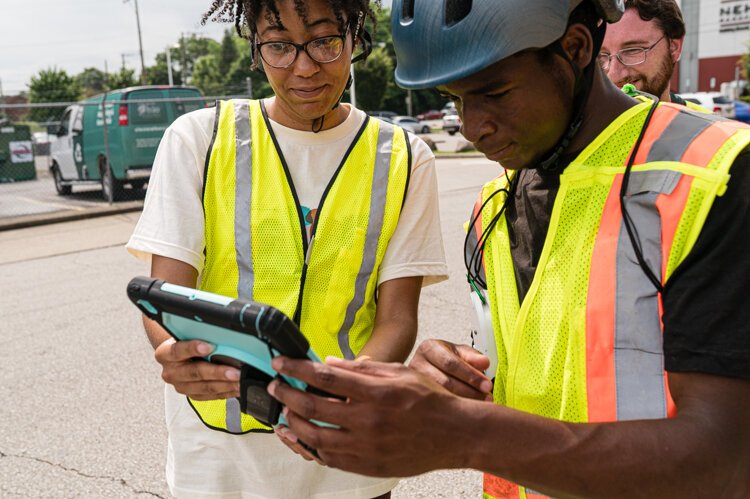Can form-based codes restore Cincinnati’s urbanity?
City of Cincinnati staff, in conjunction with several local groups including the Cincinnati chapter of the Urban Land Institute, is exploring the use of form-based codes as an alternative to the traditional zoning process. Can this new development tool restore Cincinnati’s business districts to the historic, dense, and walkable nodes that they were built to be?
City of Cincinnati staff, in conjunction with several local groups including the Cincinnati chapter of the Urban Land Institute, is exploring the use of form-based codes (FBCs) as an alternative to the traditional zoning process.
The collaborative group, spearheaded by Cincinnati City Councilmember Roxanne Qualls, has made two trips to Nashville to study how their localized use of FBCs has led to rapid redevelopment.
“They’re a really powerful tool building strong neighborhoods and spurring business development,” Qualls says.
FBCs address the relationship between building facades and streets, the form and mass of buildings in relation to each other, and the scale of streets and blocks to achieve a specific urban form.
“It provides a framework for physical development, while preserving aspects of the community like walkability, compactness, and quality of life,” Qualls says.
Form based codes commonly include:
- A regulating plan designating where different building form standards apply
- Public space standards that specify elements such as sidewalks, on-street parking, and street trees
- Building form standards that control the form, features and functions of buildings
- A clear application and project review procss
- A set of definitions that spell out the code’s technical terms
FBCs can also include elements of design overlay districts such as signage and landscaping standards, but, unlike overlay districts, they are regulatory rather than advisory.
“Form-based codes can address entire neighborhoods, business districts, corridors, or whatever level of focus the community needs,” Qualls says.
Seaside and the birth of FBCs
The first attempt at modern FBCs is widely credited to Andres Duany and Elizabeth Plater-Zyberk of DPZ, who designed the Florida resort town of Seaside in 1982.
As pioneers in the New Urbanism movement, the architects were faced with the challenge of creating an entire 80-acre town that could revive Florida’s building tradition without creating a project that looked too manufactured.
Rather than using conventional, or Euclidean zoning, Duany and Plater-Zyberk developed a set of guidelines, dubbed “SmartCode“, that allowed developers to build within a certain set of forms, rather than on land uses.
As a result, the master-planned community was built at higher densities than typical suburban communities are allowed and has a walkable, intimate small-town feel that’s been its strongest selling point.
Lessons from Seaside have morphed into FBCs, with cities such as Toronto, Nashville, Louisville, and Arlington, Virginia adopting some form of the code.
Problems with ‘Euclidean’ zoning
Euclidean zoning tends to focus on the segregation of types of land use and the regulation of arbitrary parameters such as the number of units allowed per acre, setbacks, and parking ratios.
What often results is development that elevates the ease of automobile access over the safety of the pedestrian.
“Conventional Euclidean zoning is what has produced sprawl and has led to the sad deterioration of our historic neighborhoods and the neglect of walkability,” Qualls says. “We can see the consequences. We see the shopping centers and auto-oriented development, or what some would call ‘monodevelopment’.”
Qualls says that separate and isolated land uses, going hand-in-hand with an auto-dependent transportation network, have made it difficult for people to enjoy spur-of-the-moment activities like dining, shopping, or entertainment.
“It challenges most peoples’ ability to meet their daily needs, and it undermines the traditional, vibrant neighborhoods that people like to live in,” she says.
And in an era of rising energy prices, Qualls believes that such development practices can’t continue.
“It’s not a sustainable practice,” she says. “It’s totally based upon the category of land use, and it’s not concerned about urbanity.”
Community support crucial
FBCs fold zoning, subdivision regulations, urban design controls, and public works standards into one unified document.
Because of this, Qualls says that bridging the learning curve for people that are used to Euclidean zoning requires the participation of residents, community councils, business associations, and other stakeholders.
“The heart of the development of form-based codes is a very open, very robust public participation process,” she says.
One of the common misconceptions about FBCs is that, without strict land use controls, they will allow dirty and dangerous factories to be built next to peoples’ homes.
“Form based codes don’t throw land use out the window,” Qualls says. “They recognize that there are appropriate contexts for heavy industry that may not be appropriate for mixed-use areas.”
She adds that these are exactly the kind of issues that the public process is meant to identify, and that the identification of these issues will be codified when the FBC is adopted, eliminating any possible gray areas.
“It is not an open-ended process,” Qualls says. “It’s a nine-month, interactive process. Once the community has signed off on it and council approves, it’s done.”
Development quicker
During the trip to Nashville, the collaborative group was stunned at the pace of development occurring in areas that had adopted FBCs such as The Gulch, East Nashville, Lenox Village and Hills Center.
“We saw tremendous development in neighborhoods where form-based codes were adopted,” Qualls says. “Not only that, but the quality of what’s being built. You begin to see a level of specificity in the look of the projects.”
Once FBCs are in place, the developer is free to go to work as long as he agrees to abide by the code.
Qualls says that, because the various levels of city approvals are eliminated, approval times can be slashed from several months to several weeks.
“It’s remarkable to see the speed in which you start to see development occur,” she says. “And it’s a predictable development environment, knowing that if they conform to the code, their neighbor will as well.”
The result of FBCs is a diversity of architecture, materials, uses, and ownership, creating a more organic end-product.
And because they regulate development at the scale of an individual building or lot, they lessen the need for large land assemblies and megaprojects and make redevelopment more attractive to smaller developers.
Next steps
Several city neighborhoods have expressed interest in implementing FBCs, including College Hill, Madisonville, Pleasant Ridge and Westwood.
This week, Qualls will introduce a council motion directing the city to begin exploring the feasibility of exploring FBCs on a limited basis.
And in early October, an informational conference is planned to introduce the idea to people involved in community development.
“This is not a simple concept,” Qualls says. “There is definitely a learning curve. We’re not at a stage where we can give a great visual presentation, so that’s what we’re working on.”
NOTE: A future article will address lessons learned from Nashville and some of the ideas for how FBCs can be applied in Cincinnati.














